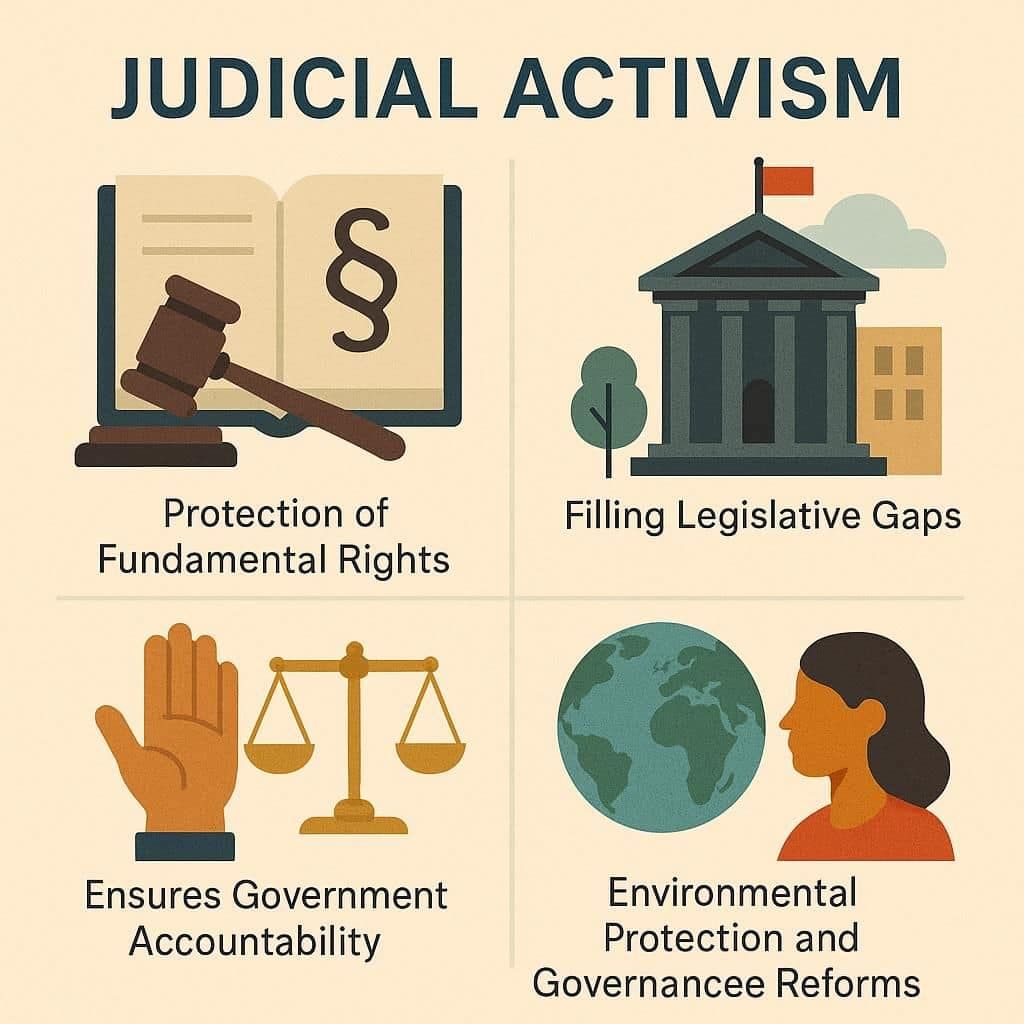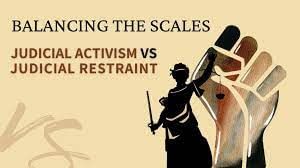Laxmikanth Summary: Judicial Activism | Indian Polity for UPSC CSE PDF Download
Introduction
The idea of judicial activism was first recognized and evolved in the USA. The term was introduced by Arthur Schlesinger Jr., an American historian and educator, in 1947.
In India, the concept of judicial activism began to take shape in the 1970s. Justices V.R. Krishna Iyer, P.N. Bhagwati, O. Chinnappa Reddy, and D.A. Desai played pivotal roles in establishing judicial activism within the nation.
Meaning of Judicial Activism
Judicial activism refers to the proactive stance taken by the judiciary to safeguard citizens' rights and advance justice within society. Essentially, it represents the assertive efforts of the judiciary to ensure that both the legislature and executive branches fulfill their constitutional obligations.
Also termed as "judicial dynamism", it stands in contrast to "judicial restraint", which describes the judiciary's exercise of self-discipline.
Aspects of Judicial Activism
The Indian Judiciary primarily focuses on two main aspects of judicial activism:
- First Aspect: This involves the courts issuing directives to government bodies to safeguard citizens' rights and uphold matters of public interest. Instances of Public Interest Litigation (PIL) exemplify this facet of judicial activism.
- Second Aspect: Another significant facet in India relates to the interpretation of fundamental rights, especially those enshrined in Article 14 (right to equality), Article 19 (right to freedom), and Article 21 (right to life and personal liberty). The judiciary has broadened the understanding and application of these rights through its constitutional interpretations.
Judicial Review Versus Judicial Activism
While closely linked, the concepts of judicial review and judicial activism have distinct differences. Here's a breakdown of their nuances:
- In the mid-20th century, particularly in the USA, a specific type of judicial review began to be referred to as judicial activism. In India, there's often confusion between the two. In essence, judicial activism represents a form of judicial review where judges not only assess the constitutionality of laws but also influence policy outcomes based on their preferences.
- While judicial review focuses on interpreting laws according to constitutional standards, judicial activism involves adapting laws to reflect evolving societal and economic dynamics, ensuring the foundational principles of the constitution remain relevant.
- The term "judicial activism" emerged in the 20th century, describing instances where judges actively shape or influence legislation. While its precise definition remains debated, it generally underscores the significance of a robust judiciary and its role in upholding fundamental rights through judicial review.
- Courts have allowed more people to approach them for justice through Public Interest Litigations (PILs), even if those people are not directly affected. This broader permission has increased the powers of the courts to check the actions of the government. Some people criticize this and call it “judicial activism.”
- Judicial activism, especially in cases related to the Constitution, is a part of what we call judicial review. It refers to situations where courts step in and cancel laws passed by the government if they believe those laws go against the Constitution.
Justification of Judicial Activism
Dr. B.L. Wadehra present various justifications for the phenomenon of judicial activism:
- Governmental Collapse: When the Legislature and Executive branches falter in their duties, it undermines citizens' faith in the Constitution and democracy.
- Trust in Judiciary: The public often turns to the judiciary to safeguard their rights, placing significant responsibility on the courts to assist those in distress.
- Judicial Enthusiasm: Judges may be inclined to contribute to societal reforms, fostering the growth of Public Interest Litigation and broadening the scope of 'Locus Standi'.
- Legislative Gaps: In instances where certain issues remain unaddressed by legislation, the court may step in to ensure societal needs are met through judicial directives.
- Constitutional Provisions: The Indian Constitution itself offers provisions that grant the judiciary latitude to legislate or actively engage in governance.
Subhash Kashyap says that in certain special situations, the judiciary may need to enter areas usually handled by the legislature or executive, such as:
- When the legislature fails to perform its responsibilities.
- In a situation of a hung legislature, where the government is weak, unstable, and focused more on survival than on decision-making, avoiding any action that may upset castes, communities, or groups.
- When those in power avoid hard decisions due to fear of losing power, and shift issues to courts to delay or pass the blame.
- When both legislature and executive fail to protect basic rights of citizens like Right to life with dignity, Clean and healthy environment and Fair and efficient legal system
- When the judiciary is misused by a strong, authoritarian government for selfish political motives, as during the Emergency.
- When even the courts fall prey to human weaknesses, such as:
- Desire for popularity
- Publicity
- Populism
Activators of Judicial Activism

Upendra Bakshi, a renowned legal expert, categorizes the catalysts behind judicial activism as follows:
- Civil Rights Advocates: Groups primarily concerned with civil and political rights matters.
- People Rights Activists: Organizations emphasizing social and economic rights, especially when these rights are challenged by state actions.
- Consumer Rights Organizations: Entities addressing consumer protection issues, focusing on the accountability of both the political and economic systems.
- Bonded Labour Activists: Groups advocating for the complete eradication of exploitative labor practices in India.
- Citizens for Environmental Action: Groups striving to engage the judiciary in combating escalating environmental challenges and pollution.
- Citizen Groups against Large Irrigation Projects: Entities demanding that the Indian judiciary refrain from issuing orders against large-scale irrigation initiatives.
- Rights of Child Groups:These groups work on issues like child labour, right to education, juvenile justice, and rights of children of sex workers.
- Custodial Rights Groups: They focus on the rights of prisoners, women in protective custody, and people under preventive detention.
- Poverty Rights Groups: These groups deal with problems related to drought, famine relief, and urban poor.
- Indigenous People's Rights Groups: They fight for forest dwellers, tribal communities, and citizens under the Fifth and Sixth Schedules of the Constitution, along with identity rights.
- Women's Rights Groups: They raise issues of gender equality, violence and harassment against women, rape, and dowry deaths.
- Bar-based Groups: These groups demand judicial autonomy and accountability of the Indian judiciary.
- Media Autonomy Groups: They focus on freedom and accountability of the press and state-owned media.
- Assorted Lawyer-Based Groups: Includes lawyers' collectives fighting for various legal and social issues.
- Assorted Individual Petitioners: Refers to individual activists or freelance petitioners who take up public causes.
Apprehensions of Judicial Activism
Upendra Bakshi, a distinguished legal expert, identified various apprehensions associated with judicial activism. He noted: "These concerns encompass a broad spectrum of fears, aiming to instill caution among India's most diligent judges." Bakshi outlined the following categories of concerns:
- Ideological Concerns: Are judges overstepping their boundaries and encroaching upon the roles of the legislature, executive, or other independent bodies within a democratic setup?
- Epistemic Fears: Do judges possess adequate expertise in specialized fields, such as the economic insights akin to Manmohan Singh or the scientific acumen demonstrated by leading figures in atomic energy and research councils?
- Management Fears: By taking on a substantial volume of litigation, are judges inadvertently contributing to an already overwhelming backlog of cases?
- Legitmation Fears: Could the judiciary be diminishing its symbolic authority by issuing directives in public interest matters that the executive might overlook or sidestep? Might this erode public trust in the judiciary as a democratic recourse?
- Democratic Fears: Is the rise in Public Interest Litigation (PIL) helping to strengthen democracy by giving voice to the people, or is it weakening democratic institutions like the legislature and executive by allowing the judiciary to take over their roles?
- Biographic Fears: Judges may wonder: "If I get too involved in public interest cases now, how will it affect my image or role in public life after retirement?"
Judicial Activism vs. Judicial Restraint

Meaning of Judicial Restraint
In the United States, judicial activism and judicial restraint represent two distinct judicial approaches. Proponents of judicial restraint believe that judges should adhere strictly to their defined role: interpreting the law without overstepping into the realm of law creation, which is the responsibility of the legislative and executive branches. Furthermore, judges should avoid letting personal political beliefs influence their legal interpretations. This perspective emphasizes that courts should be guided by the 'original intent' of the constitution's framers and its subsequent amendments.
Assumptions of Judicial Restraint
In the United States, the principle of judicial restraint rests on six core beliefs:
- Court Composition: The Court, being unelected, is seen as potentially undemocratic and, due to this perception of being oligarchic, should generally defer to branches of government more directly accountable to the populace.
- Origin of Judicial Review: There are doubts about the roots of the significant power of judicial review, especially since it isn't explicitly outlined in the Constitution.
- Separation of Powers: The traditional principle of separating governmental powers influences this doctrine.
- Federalism: The division of authority between the federal and state levels necessitates that the Court respects decisions made by state officials and bodies.
- Pragmatic Considerations: Given its reliance on Congress for jurisdiction and resources, as well as the need for public trust, the Court should be cautious about exceeding its defined role.
- Legal Tradition: The Court, as a guardian of the Anglo-American legal tradition, should maintain a balance, refraining from excessive involvement in political matters, which are viewed as being about power and influence rather than reasoned judgment.
It's worth noting that most of these assumptions, with the exception of the one related to the origins of judicial review, are also relevant in the context of the Indian judiciary.
Supreme Court's Stand on Judicial Restraint
In a landmark judgment from December 2007, the Supreme Court of India underscored the importance of judicial restraint. The Court emphasized the need for each branch of the state to respect its boundaries and refrain from overstepping into the realms of other branches. Here are the key takeaways from the Court's observations:
- Limits of Judicial Role: The Court expressed concern over instances where judges appeared to be assuming roles that rightfully belong to the executive or legislative branches, stating that such actions violate constitutional norms.
- Role of Judges: Judges were advised to operate within their designated roles and not overreach. The Court stressed the importance of humility and cautioned against any imperial behavior.
- Separation of Powers: The Court referenced Montesquieu's 'The Spirit of Laws', emphasizing the philosopher's warnings on the dangers of blurring the lines between the three branches of government, especially pertinent given recent criticisms of judicial overreach.
- Activism vs. Adventurism: While advocating for judicial activism, the Court warned against crossing into judicial adventurism, emphasizing the importance of adhering to established judicial norms and preferences.
- Respect for Expertise: Recognizing the specialized skills of administrative bodies, the Court emphasized that courts should avoid undermining their decisions
|
151 videos|780 docs|202 tests
|
FAQs on Laxmikanth Summary: Judicial Activism - Indian Polity for UPSC CSE
| 1. What is the meaning of judicial activism? |  |
| 2. What is the difference between judicial review and judicial activism? |  |
| 3. What are the reasons for judicial activism? |  |
| 4. How does judicial activism differ from judicial restraint? |  |
| 5. What is the Supreme Court's stand on judicial restraint? |  |

















